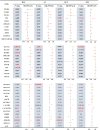Exploring genes associated with metabolic dysfunction as therapeutic targets for head and neck cancers: a novel strategy
- PMID: 39907620
- PMCID: PMC12175778
- DOI: 10.1097/JS9.0000000000002293
Exploring genes associated with metabolic dysfunction as therapeutic targets for head and neck cancers: a novel strategy
Abstract
Evidence suggests a potential link between metabolic dysfunction and head and neck cancer (HNC). This study investigates the potential causal relationships between metabolic dysfunction and HNC using genetic data. While no significant causal associations were identified between metabolic indicators and HNC risk, the research revealed that inhibition of certain genes could reduce cancer risk. Specifically, inhibiting sodium/glucose cotransporter 2 (SLC5A2) was associated with a decreased risk of HNC and oropharyngeal cancer (OPC), while ATP-sensitive inward rectifier potassium channel 11 inhibition was linked to a reduced risk of oral cavity cancer. Additionally, inhibiting SLC5A1 and voltage-dependent L-type calcium channel subunit beta-2 showed a connection to lower OPC risk. These findings suggest that targeting these genes could offer promising therapeutic strategies for preventing and treating HNC, as well as improving both preoperative and postoperative management in affected patients.
Keywords: Mendelian randomization; drug targets; head and neck cancer; metabolic dysfunction.
Copyright © 2025 The Author(s). Published by Wolters Kluwer Health, Inc.
Conflict of interest statement
The author declares that the research was conducted in the absence of any commercial or financial relationships that could be construed as a potential conflict of interest.
Figures



Similar articles
-
Influence of religion and spirituality on head and neck cancer patients and their caregivers: a protocol for a scoping review.Syst Rev. 2025 Jan 28;14(1):27. doi: 10.1186/s13643-025-02768-5. Syst Rev. 2025. PMID: 39875944 Free PMC article.
-
Correlations between genetically predicted iron-supplement drug targets and inflammatory bowel disease: A Mendelian randomization study.Medicine (Baltimore). 2025 Jun 13;104(24):e42729. doi: 10.1097/MD.0000000000042729. Medicine (Baltimore). 2025. PMID: 40527798 Free PMC article.
-
Molecular feature-based classification of retroperitoneal liposarcoma: a prospective cohort study.Elife. 2025 May 23;14:RP100887. doi: 10.7554/eLife.100887. Elife. 2025. PMID: 40407808 Free PMC article.
-
Prenatal administration of progestogens for preventing spontaneous preterm birth in women with a multiple pregnancy.Cochrane Database Syst Rev. 2019 Nov 20;2019(11):CD012024. doi: 10.1002/14651858.CD012024.pub3. Cochrane Database Syst Rev. 2019. PMID: 31745984 Free PMC article.
-
Olaparib Monotherapy or in Combination with Abiraterone for the Treatment of Patients with Metastatic Castration-Resistant Prostate Cancer (mCRPC) and a BRCA Mutation.Target Oncol. 2025 May;20(3):445-466. doi: 10.1007/s11523-025-01146-4. Epub 2025 May 21. Target Oncol. 2025. PMID: 40397306 Free PMC article. Review.
References
-
- Siegel RL, Giaquinto AN, Jemal A. Cancer statistics, 2024. Ca A Cancer J Clin 2024;74:12–49. - PubMed
-
- Marur S, Forastiere AA. Head and neck squamous cell carcinoma: update on epidemiology, diagnosis, and treatment. Mayo Clin Proc Mar 2016;91:386–96. - PubMed
-
- Samson SL, Garber AJ. Metabolic syndrome. Endocrinol Metab Clin North Am 2014;43:1–23. - PubMed
MeSH terms
LinkOut - more resources
Full Text Sources
Medical

